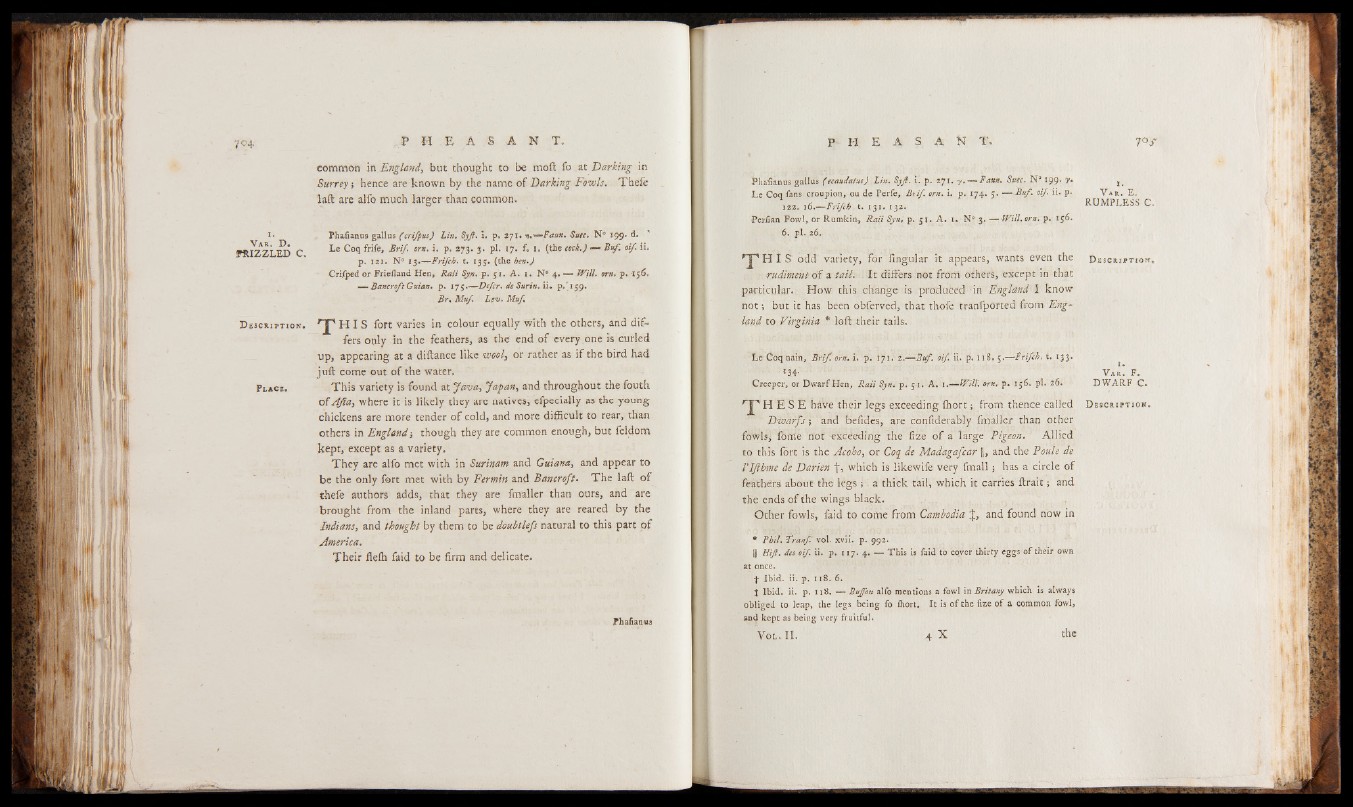
7C4 JP H E A .3 A N T .
common m England, but thought to be moit fo at Barking in
Surrey $ hence are known by the name of Barking Fowls. Thefe
laft are alfo much larger than common.
*• Phafianus gallus ( crifpus) Lin, Syjl, i. p. 371. *,'—Faun, Suee, N° 199. d.
FRIZZLED C ^rif ' orn' *' P* 273* 3* P** ** *' l| | | <0C^'J fN|j 0lf ' jf*
p. 121. N° 13.— Frifch. t. 135. (the hen.)
Criiped or Friefland Hen, Rail Syn. p. 51. A. 1. N° 4. — Will, orn, p. 156.
—- Bancroft Guian, p. 175.-—Defer, de Suriti. ii. p/159.
Br, Muf Lev. Muf,
D escription, T 1 H I S fort varies in colour equally with the others, and differs
only in the feathers, as the end of every one is curled
up, appearing at a diftance like wool, or rather as if the bird had
juft come out of the water.
Place. This variety is found at Java, Japan, and throughout the fouth
of Afta, where it is likely they are natives, efpecially as the young
chickens are more tender of cold, and more difficult to rear, than
others in England-, though they are common enough, but feldom
kept, except as a variety.
They are alfo met with in Surinam and Guiana, and appear to
be the only fort met with by Fermin and Bancroft. The laft of
thefe authors adds, that they are fmaller than ours, and are
brought from the inland parts, where they are reared by the
Indians, and thought by them to be doubtlefs natural to this part of
America.
Their fleih faid to be firm and delicate.
Fhafianus
P H E A S A N Tv 7°X
Phatianus gallus (eeatidatus) Lin. Syjl. i. p. 271. y. — Faun. Suec. N° 199. y*
Le Coq Tans croupion, ou de Perfe, B? if. orn. i. p. 174. 5. — Bu/, oif ii. p.
122. 16.— Frifch. t. 131. 132.
Perfian Fowl, or Rumkin, Raii Syn, p. 51. A. 1. N° 3. — Will. orn. p. i$6.
<5. pl. 26.
H I S odd variety, for lingular it appears, wants even the
-rudiment o î a tail. . It differs not from others, except in that
particular. How this change is produced in England \ know
not -, but it has been obferved, that thofe tranfported from England
to Virginia * loft their tails.
V ar. E.
RUMPLESS C.
D escription. if
Le Coq nain, Brif. orn. i. p. 171. 2.— Buf. oif. ii. p. 118. 5.— Frifch. t. 133.
• *314- ' ' : ; ’ ■
Creeper, or Dwarf Hen, Raii Syn. p. 51. A. i.— Will. orn. p. 156. pl. 26.
T H E S E have their legs exceeding ffiort; from thence called
Diaarfs j and befides, are confiderably fmaller than other
fbwls, fome not exceeding the fize of a large Pigeon. Allied
to this fort is the Acoho, or Coy de Madagafcar [|, and the Poule de
I’lfthme de Darien which is likewife very fmall s has a circle of
feathers about the legs; a thick tail, which it carries ftrait; and
the ends of the wings blapk.
Other fowls, faid to come from Cambodia J, and found now in
• Phil. Tranf. vol. xvii. p. 992.
fj Hiß. des oif ii. p. 117. 4. — This is faid to cover thirty eggs of their own
at once.
f Ibid. ii. p. 118. 6.
J Ibid. ii. p. 118. — Buffon alfo mentions a fowl in Britany which is always
obliged to leap, the legs being fo fliort. It is of the fize of a common fowl,
and kept as being very fruitful.
Vol. II. .4 X the
V ar. F.
DWARF C.
D escription.
|1 §
yilpl
E l